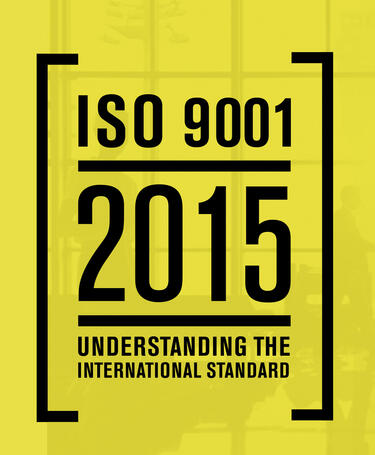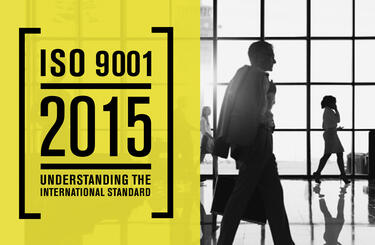
ISO 9001:2015: 15 ways to improve quality
Progress indicator

Bastine Paul says ISO 9001:2015 is one of the best standards for Quality Management Systems. Significant change to the revised standard gives various ways for quality improvement. Here are 15 effective ways ISO 9001:2015 can boost quality improvement.
1. Leadership
Clause 5.1.1 a) “Top management shall demonstrate leadership and commitment with respect to the quality management system by taking accountability for the effectiveness of the quality management system.”
In earlier standards, quality is side-lined to the quality manager. However, a major shift has taken place and leaders are now responsible for quality.
The direction, drive and path towards quality can be more effective, efficient and strategic as the leader holds authority over the organisation.
This change will have a major impact on all industries. Leadership will hopefully drive the organisation towards quality excellence.
2. Quality Objectives
Clause 6.2.1 states: “The organisation shall establish quality objectives at relevant functions, levels and processes needed for the quality management system."
After the leadership takes over the responsibility of quality, the next best thing they can do is set the quality objectives so that they align with the vision of the organisation.
3. Quality Policy
Clause 5.2.1 d) “Top management shall establish, implement and maintain a quality policy that includes a commitment to continual improvement of the quality management system."
The earlier quality policy was a statement framed and hung on a wall, but now leaders can use it as a tool to implement the right direction and overall intentions.
The best quality policies in the world are very simple, effective but have specific purposes.
4. Quality Planning
Clause 6.2.2 states: “When planning how to achieve its quality objectives, the organisation shall determine:
a) what will be done
b) what resources will be required
c) who will be responsible
d) when it will be completed
e) how the results will be evaluated.
5. Legal Compliance
Clause 1 b) “This International Standard specifies requirements for a quality management system when an organisation aims to enhance customer satisfaction through the effective application of the system, including processes for improvement of the system and the assurance of conformity to customer and applicable statutory and regulatory requirements.”
A major setback recently occurred to quality when 20 million cars, worldwide, were recalled from different manufacturers..
However, the quality of products and services is always improving, and in that way society is benefitting from quality improvement.
6. Safety Design
Clause 8.3.5 d) “The organisation shall ensure that design and development outputs specify the characteristics of the products and services that are essential for their intended purposes and their safe and proper provision.”
Here safety is one of the characteristics of quality. Safety is achieved by quality design, quality process and quality performance.
In 2013, 50 of Boeing’s 787 Dreamliners were grounded because of battery failures. Boeing identified potential causes of the failures and they eliminated them through better quality design. Boeing developed more insulation between each battery's cells and a fireproof shell for the battery to starve it of oxygen in case of a fire. The improvements were added before the planes returned to the skies.
7. Risk Based Thinking (Negative)
Clause No. 6.1.1 c) “When planning for the quality management system, the organisation shall consider the issues referred to in 4.1 and the requirements referred to in 4.2 and determine the risks and opportunities that need to be addressed to prevent, or reduce, undesired effects”.
A key benefit of this is that it creates an enhanced focus on root cause investigation and determination, followed by prevention and corrective actions.
8. Risk Based Thinking (Positive)
Clause No. 6.1.1 d) “When planning for the quality management system, the organisation shall consider the issues referred to in 4.1 and the requirements referred to in 4.2 and determine the risks and opportunities that need to be addressed to achieve improvement.”
This is the first time an ISO standard has addressed the positive side of risk by viewing it as an opportunity.
Opportunities can lead to the adoption of new practices, launching new products, opening new markets, addressing new clients, building partnerships, using new technology and other desirable and viable possibilities to address the organisation’s or its customers’ needs.
9. Correction and Corrective Action
Clause No. 10.2.1 a) When a nonconformity occurs, including any arising from complaints, the organisation shall react to the nonconformity and, as applicable take action to control and correct it”.
Clause 10.2.1 b) “When a nonconformity occurs, including any arising from complaints, the organisation shall evaluate the need for action to eliminate the cause(s) of the nonconformity, in order that it does not recur or occur elsewhere, by reviewing and analysing the nonconformity; determining the causes of nonconformity; and determining if similar nonconformities exist, or could potentially occur.
Corrections and corrective actions are not the same thing, but have distinguishing features.
10. Continual improvement
Clause 10.3: “The organisation shall continually improve the suitability, adequacy and effectiveness of the quality management system.”
Continual improvement is one of the constant ways and one of the surest ways of improvement. It is recurring activity to enhance performance.
11. Breakthrough Change
Clause 10.1 NOTE: “Examples of improvement can include correction, corrective action, continual improvement, breakthrough change, innovation and re-organisation.”
Quality improvement has often happened in the history of mankind by a breakthrough change or by invention.
12. Innovation
Clause No. 10:.1 a): Organisations shall improve “products and services to meet requirements as well as to address future needs and expectations”.
In 1940 John Baird, UK, invented the Colour Television. In 2004 Sony introduced the first LED TV to the world. They showed innovation is marketable when it meets the needs and expectations of customers.
13. Re-organisation
Clause No. 10.3: “The organisation shall continually improve the suitability, adequacy and effectiveness of the quality management system.”
By using the same resources, through re-organisation, an organisation can improve its performance.
14. Any action to enhance customer satisfaction
Clause No.10.1: “The organisation shall determine and select opportunities for improvement and implement any necessary actions to meet customer requirements and enhance customer satisfaction.”
This clause is very challenging, evolutionary and revolutionary.
Implementers and followers can think through any idea, strategy, methodology and tool to implement actions for quality improvement and to enhance customer satisfaction.
This is the first time an ISO QMS Standard has been so open, liberal and widely adoptable for the advantages of users and customers.
15. Management Review
Clause No. 9.3.3 a) : “The outputs of the management review shall include decisions and actions related to opportunities for improvement”.
Starting with leadership and ending with leadership by management review, top management should review the organisation’s quality management system, at planned intervals.
This will ensure its continuing suitability, adequacy, effectiveness and alignment with the strategic direction of the organisation and opportunities for improvement.
Top management can consider changes in external and internal issues that are relevant to the quality management system.
Leaders can review the compliance of a quality management system to meet societal needs and expectations, statutory and regulatory, environmental and stakeholder requirements.
When an organisation is aligned towards sustained success through sustainable development initiatives and by satisfying the entire stakeholders such as customers, internal customers, shareholders, suppliers, society, government, environment and all other interested parties, quality is improved and sustained success can be achieved.
Bastine Paul is a consultant with Millenniya Management.